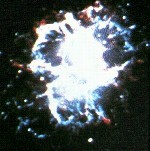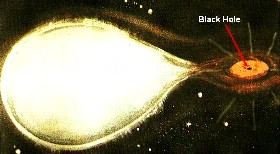
 When a giant star, more massive and hotter than our sun, runs out of fuel, it collapses.
Radiation pressure can no longer keep the huge gravitational forces from pulling the
material of the star inwards. When the outer layers fall inward and hit the hot core, a
truly enormous explosion occurs. The star explodes, releasing light and other electromagnetic energy in such quantities that this supernova can be seen at immense distances.
In the process, any planets that may have been circling the star are vapourized...and the
radiation is strong enough that it may even inundate the planets of 'nearby' stars.
(One possible theory for the extinction of the dinosaurs on earth was the occurrence of a
supernova in the sun's galactic neighbourhood.)
When a giant star, more massive and hotter than our sun, runs out of fuel, it collapses.
Radiation pressure can no longer keep the huge gravitational forces from pulling the
material of the star inwards. When the outer layers fall inward and hit the hot core, a
truly enormous explosion occurs. The star explodes, releasing light and other electromagnetic energy in such quantities that this supernova can be seen at immense distances.
In the process, any planets that may have been circling the star are vapourized...and the
radiation is strong enough that it may even inundate the planets of 'nearby' stars.
(One possible theory for the extinction of the dinosaurs on earth was the occurrence of a
supernova in the sun's galactic neighbourhood.)
In our galaxy, it has been estimated that one or two stars become supernovas every year.
Each century, there are one or two that become visible to the naked eye. Where no star was
visible before, suddenly there is a very bright object.  The explosion happens very fast,
perhaps in a matter of hours; visible signs of the explosion linger for months.
The picture at the top of this page is of the Crab Nebula, a remnant of a star which exploded
as a supernova about 1000 years ago. There are written records of observations made as
the star suddenly brightened in the sky...now what is left is only visible in a telescope...
but is clearly the remains of a star that exploded as a supernova.
The explosion happens very fast,
perhaps in a matter of hours; visible signs of the explosion linger for months.
The picture at the top of this page is of the Crab Nebula, a remnant of a star which exploded
as a supernova about 1000 years ago. There are written records of observations made as
the star suddenly brightened in the sky...now what is left is only visible in a telescope...
but is clearly the remains of a star that exploded as a supernova.
When the star explodes, the inward pressure on the core of the star is so high that it compresses
the material at the center to fantastic densities. Where a normal star ends life as a nova,
leaving behind a dense white dwarf star, a supernova leaves in its wake a super-compressed
ball of material called a neutron star ... so dense that all protons and electrons in the material
have been forced together into neutrons. A neutron star is about the size of a mountain, but has
a mass equivalent to our sun. A pencil made from neutron star matter would weigh 15 billion tons!
If the neutron star happens to be rotating, and some instabilities cause it to be giving off bursts
of energy, we will observe these pulses as a regular signal...this kind of star is called a 'pulsar'.
There is one of these at the center of the Crab Nebula.
If the star which explodes was a supergiant, much more massive than our sun, then the
pressures of the explosion may cause the star's core to be compressed even further, into a tiny
object that is so dense, none of the light and radiation it emits can escape its own gravity. Such a remnant is called a Black Hole. We can detect these
because of the intense radiation emitted, not by the Black Hole itself, but by interstellar material falling into the 'hole'. Stars often come in pairs (called a 'binary' star system), and if one of them becomes a Black Hole, it will start to suck material in from the other star. This material falling in to the black hole gives off intense radiation. to be compressed even further, into a tiny
object that is so dense, none of the light and radiation it emits can escape its own gravity. Such a remnant is called a Black Hole. We can detect these
because of the intense radiation emitted, not by the Black Hole itself, but by interstellar material falling into the 'hole'. Stars often come in pairs (called a 'binary' star system), and if one of them becomes a Black Hole, it will start to suck material in from the other star. This material falling in to the black hole gives off intense radiation.
Back
Site Map | Main Page
|

